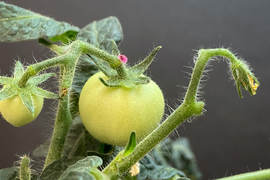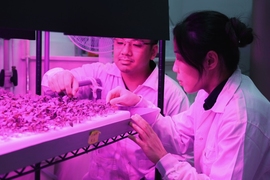Researchers from the Disruptive and Sustainable Technologies for Agricultural Precision (DiSTAP) interdisciplinary research group within the Singapore-MIT Alliance for Research and Technology have developed the world’s first near-infrared fluorescent nanosensor capable of real-time, nondestructive, and species-agnostic detection of indole-3-acetic acid (IAA) — the primary bioactive auxin hormone that controls the way plants develop, grow, and respond to stress.
Auxins, particularly IAA, play a central role in regulating key plant processes such as cell division, elongation, root and shoot development, and response to environmental cues like light, heat, and drought. External factors like light affect how auxin moves within the plant, temperature influences how much is produced, and a lack of water can disrupt hormone balance. When plants cannot effectively regulate auxins, they may not grow well, adapt to changing conditions, or produce as much food.
Existing IAA detection methods, such as liquid chromatography, require taking plant samples from the plant — which harms or removes part of it. Conventional methods also measure the effects of IAA rather than detecting it directly, and cannot be used universally across different plant types. In addition, since IAA are small molecules that cannot be easily tracked in real time, biosensors that contain fluorescent proteins need to be inserted into the plant’s genome to measure auxin, making it emit a fluorescent signal for live imaging.
SMART’s newly developed nanosensor enables direct, real-time tracking of auxin levels in living plants with high precision. The sensor uses near infrared imaging to monitor IAA fluctuations non-invasively across tissues like leaves, roots, and cotyledons, and it is capable of bypassing chlorophyll interference to ensure highly reliable readings even in densely pigmented tissues. The technology does not require genetic modification and can be integrated with existing agricultural systems — offering a scalable precision tool to advance both crop optimization and fundamental plant physiology research.
By providing real-time, precise measurements of auxin, the sensor empowers farmers with earlier and more accurate insights into plant health. With these insights and comprehensive data, farmers can make smarter, data-driven decisions on irrigation, nutrient delivery, and pruning, tailored to the plant’s actual needs — ultimately improving crop growth, boosting stress resilience, and increasing yields.
“We need new technologies to address the problems of food insecurity and climate change worldwide. Auxin is a central growth signal within living plants, and this work gives us a way to tap it to give new information to farmers and researchers,” says Michael Strano, co-lead principal investigator at DiSTAP, Carbon P. Dubbs Professor of Chemical Engineering at MIT, and co-corresponding author of the paper. “The applications are many, including early detection of plant stress, allowing for timely interventions to safeguard crops. For urban and indoor farms, where light, water, and nutrients are already tightly controlled, this sensor can be a valuable tool in fine-tuning growth conditions with even greater precision to optimize yield and sustainability.”
The research team documented the nanosensor’s development in a paper titled, “A Near-Infrared Fluorescent Nanosensor for Direct and Real-Time Measurement of Indole-3-Acetic Acid in Plants,” published in the journal ACS Nano. The sensor comprises single-walled carbon nanotubes wrapped in a specially designed polymer, which enables it to detect IAA through changes in near infrared fluorescence intensity. Successfully tested across multiple species, including Arabidopsis, Nicotiana benthamiana, choy sum, and spinach, the nanosensor can map IAA responses under various environmental conditions such as shade, low light, and heat stress.
“This sensor builds on DiSTAP’s ongoing work in nanotechnology and the CoPhMoRe technique, which has already been used to develop other sensors that can detect important plant compounds such as gibberellins and hydrogen peroxide. By adapting this approach for IAA, we’re adding to our inventory of novel, precise, and nondestructive tools for monitoring plant health. Eventually, these sensors can be multiplexed, or combined, to monitor a spectrum of plant growth markers for more complete insights into plant physiology,” says Duc Thinh Khong, research scientist at DiSTAP and co-first author of the paper.
“This small but mighty nanosensor tackles a long-standing challenge in agriculture: the need for a universal, real-time, and noninvasive tool to monitor plant health across various species. Our collaborative achievement not only empowers researchers and farmers to optimize growth conditions and improve crop yield and resilience, but also advances our scientific understanding of hormone pathways and plant-environment interactions,” says In-Cheol Jang, senior principal investigator at TLL, principal investigator at DiSTAP, and co-corresponding author of the paper.
Looking ahead, the research team is looking to combine multiple sensing platforms to simultaneously detect IAA and its related metabolites to create a comprehensive hormone signaling profile, offering deeper insights into plant stress responses and enhancing precision agriculture. They are also working on using microneedles for highly localized, tissue-specific sensing, and collaborating with industrial urban farming partners to translate the technology into practical, field-ready solutions.
The research was carried out by SMART, and supported by the National Research Foundation of Singapore under its Campus for Research Excellence And Technological Enterprise program. The universal nanosensor was developed in collaboration with Temasek Life Sciences Laboratory (TLL) and MIT.









